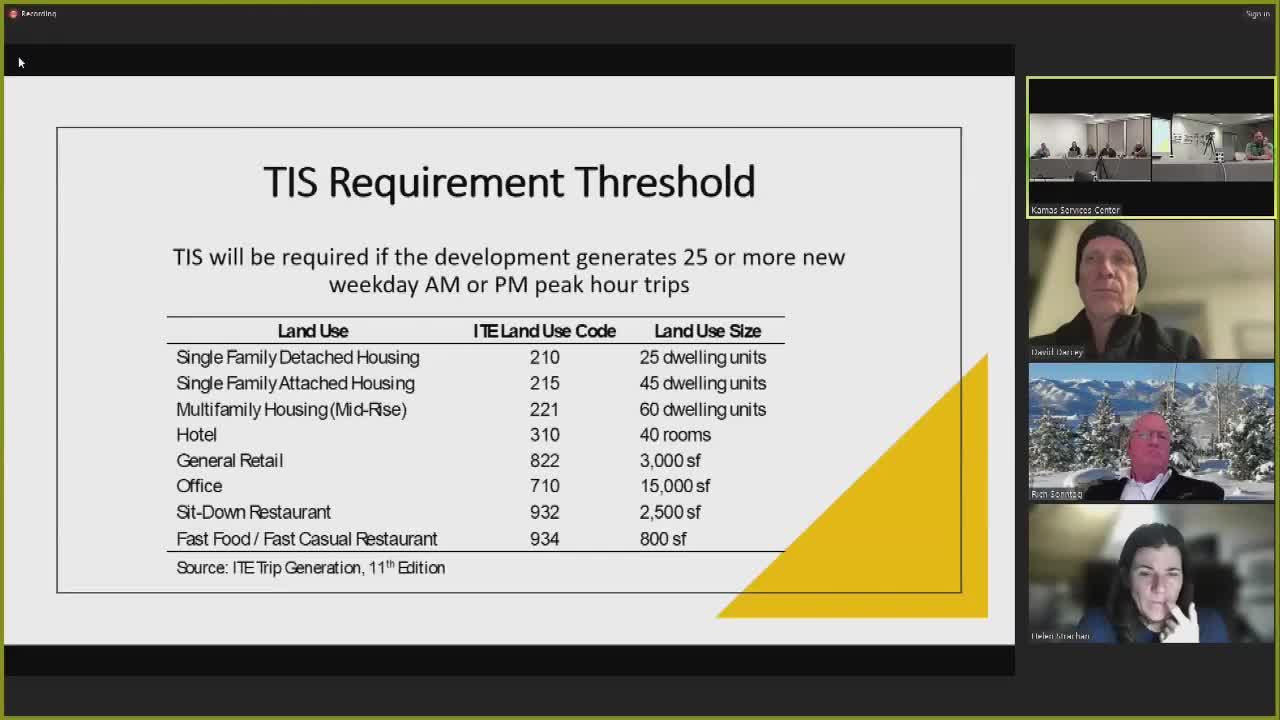Eastern Summit County debates vehicle trip generation guidelines for new developments
March 07, 2024 | Eastern Summit County Planning Commission, Summit County Commission and Boards, Summit County, Utah

This article was created by AI summarizing key points discussed. AI makes mistakes, so for full details and context, please refer to the video of the full meeting. Please report any errors so we can fix them. Report an error »

The Summit County Eastern Planning Commission meeting on March 7, 2024, focused on the impact of land use regulations and traffic generation in Eastern Summit County. Key discussions revolved around the need for updated requirements that reflect the current market dynamics and the unique characteristics of the area.
Commission members expressed concerns that existing regulations do not adequately account for the rise of smaller, specialized businesses, such as motorcycle training facilities. One member highlighted the importance of understanding how these businesses impact local traffic and community dynamics, particularly in relation to connecting various areas within the county.
A significant point of contention was the traffic generation estimates provided by the Institute of Transportation Engineers (ITE). Several commissioners questioned the validity of the ITE's trip generation manual, arguing that it underestimates the number of vehicle trips associated with new developments. For instance, one commissioner noted that a development with 25 dwelling units would likely generate more than the 25 trips suggested, given that most households have multiple vehicles.
The discussion also touched on the implications of multifamily housing and the assumption that residents would rely on public transportation. Commissioners pointed out that the current reality in Summit County is one of high car dependency, suggesting that traffic estimates should be adjusted accordingly.
In addition to residential developments, the need to consider traffic generated by recreational facilities, such as ski resorts and community centers, was emphasized. Commissioners agreed that these facilities significantly contribute to local traffic patterns and should be included in future planning considerations.
The meeting concluded with a consensus on the necessity for a comprehensive review of traffic generation metrics and land use requirements to better align with the realities of Eastern Summit County. The commission plans to further explore these issues in upcoming sessions, aiming to create regulations that support both community growth and traffic management.
Commission members expressed concerns that existing regulations do not adequately account for the rise of smaller, specialized businesses, such as motorcycle training facilities. One member highlighted the importance of understanding how these businesses impact local traffic and community dynamics, particularly in relation to connecting various areas within the county.
A significant point of contention was the traffic generation estimates provided by the Institute of Transportation Engineers (ITE). Several commissioners questioned the validity of the ITE's trip generation manual, arguing that it underestimates the number of vehicle trips associated with new developments. For instance, one commissioner noted that a development with 25 dwelling units would likely generate more than the 25 trips suggested, given that most households have multiple vehicles.
The discussion also touched on the implications of multifamily housing and the assumption that residents would rely on public transportation. Commissioners pointed out that the current reality in Summit County is one of high car dependency, suggesting that traffic estimates should be adjusted accordingly.
In addition to residential developments, the need to consider traffic generated by recreational facilities, such as ski resorts and community centers, was emphasized. Commissioners agreed that these facilities significantly contribute to local traffic patterns and should be included in future planning considerations.
The meeting concluded with a consensus on the necessity for a comprehensive review of traffic generation metrics and land use requirements to better align with the realities of Eastern Summit County. The commission plans to further explore these issues in upcoming sessions, aiming to create regulations that support both community growth and traffic management.
View full meeting
This article is based on a recent meeting—watch the full video and explore the complete transcript for deeper insights into the discussion.
View full meeting

